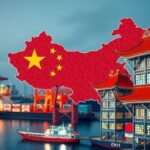Key Economic Targets for China: Expectations from Upcoming Parliament Meeting
China’s Premier Li Qiang is set to reveal the country’s primary economic goals for 2025 at the forthcoming parliament meeting. The anticipated growth target remains at about 5%, while the budget deficit may increase to 4% of GDP. Authorities plan to issue significant special treasury bonds, with a focus on job creation and inflation management. These measures aim to bolster the economy amidst ongoing challenges, particularly from external trade tensions.
China’s Premier Li Qiang is set to present the nation’s key economic objectives for 2025 during the annual parliament meeting commencing on March 5. Analysts anticipate that the government will aim for an economic growth target of approximately 5%. This goal is perceived as ambitious, considering the ongoing trade tensions with the United States which pose significant risks to China’s export sector.
The budget deficit is projected to rise to 4% of GDP for 2025, an increase from the previous year’s 3%. This adjustment aligns with the “more proactive” fiscal policy that the country’s leadership announced late last year, indicating a shift towards more aggressive economic stimulation measures.
Authorities plan to issue a historic 3 trillion yuan (around $413.13 billion) in special treasury bonds this year, vastly increasing from the 1 trillion yuan issued last year. Of this total, approximately 1.3 trillion yuan will be allocated for consumer subsidies, business enhancements, and vital investment projects, while further investments will focus on advanced sectors such as electric vehicles and green technology.
There is an expectation for an increase in local government special bond issuances as well, with estimates suggesting a quota increase to 4.7 trillion yuan, up from 3.9 trillion yuan from the previous year. This issuance is anticipated to boost municipal financing and stimulate local economic development initiatives.
Maintaining a stable employment landscape is a critical priority for policymakers. The economic environment yielded 12.56 million new urban jobs last year, surpassing the target of 12 million. Goldman Sachs anticipates a similar goal for this year, which implies an official unemployment target of around 5.0%, a reduction from the prior year’s target of approximately 5.5%.
Furthermore, local media reports suggest that China may lower its consumer price inflation target for this year to about 2%, down from approximately 3%. This adjustment comes at a time when the country faces potential deflation, as consumer prices only experienced a minimal increase of 0.2% last year.
The fiscal measures and economic targets laid out by China highlight the government’s commitment to sustaining growth and employment within a challenging global economic landscape.
The anticipated economic announcements from China’s annual parliament meeting indicate a focus on maintaining stability amid external pressures. By aiming for a 5% growth target, increasing the budget deficit, and implementing substantial bond issuances, the government seeks to stimulate the economy effectively. Furthermore, the focus on employment and inflation adjustments reflects a responsive strategy to current economic realities, underscoring the importance of strategic planning as challenges from international trade persist.
Original Source: money.usnews.com








Post Comment